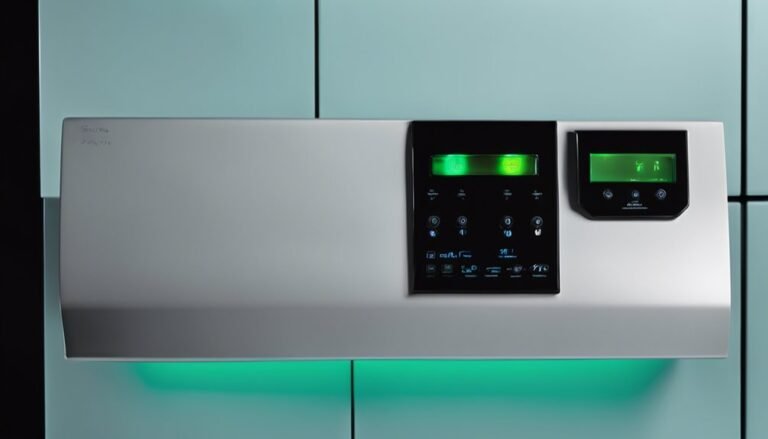How to Use Water Softner
When you're ready to use a water softener, the first step is to guarantee it's installed correctly near your main water supply. You'll need to connect the inlet and drain lines properly and set up the control panel according to your specific water hardness. Keeping an eye on salt levels in the brine tank is vital for peak performance. However, even with the right setup, there are maintenance aspects that can't be overlooked. Understanding these can markedly affect the system's efficiency—let's explore what you need to know to keep your water softener running smoothly.
Key Takeaways
- Test your water hardness to determine the appropriate water softener type needed for your household.
- Install the softener near the main water supply and ensure secure connections for incoming and drain lines.
- Program the control panel according to your water hardness levels and household water usage for optimal performance.
- Regularly monitor salt levels in the brine tank and refill as needed to maintain effective softening.
- Schedule routine maintenance, including cleaning the resin tank and inspecting inlet screens, to prolong the softener's lifespan.
Understanding Water Hardness
Water hardness refers to the concentration of minerals, mainly calcium and magnesium, present in your water supply. Understanding water hardness is vital, as it can impact everything from your plumbing to your skin.
Water hardness is typically measured on a hardness scale, which categorizes water into different levels: soft, moderately hard, hard, and very hard.
Soft water usually contains fewer than 60 mg/L of calcium carbonate, while moderately hard water ranges from 61 to 120 mg/L. Hard water falls between 121 and 180 mg/L, and anything above 180 mg/L is considered very hard. Knowing your water's hardness level helps you address potential issues and make informed choices for your household.
If your water's hard, you might notice scale buildup on faucets, cloudy dishes, or dry skin after showering. It's important to test your water hardness periodically, as it can fluctuate over time due to various factors, like changes in your water supply.
Understanding these aspects of water hardness allows you to prepare for the next steps in managing your water quality effectively. This knowledge will empower you to make informed decisions about treating your water and improving your home's overall water experience.
Choosing the Right Water Softener
When it comes to selecting the right water softener for your home, understanding your specific needs is essential. First, assess your water quality by testing for hardness levels. This will help you determine how much calcium and magnesium your system needs to combat.
There are several types of softeners to choose from, including salt-based, salt-free, and dual-tank models. Each type has its own advantages, depending on your water quality and household size.
Salt-based softeners are the most common and effectively remove hardness but require regular salt refills. Salt-free systems, on the other hand, use a different process to condition water, making them a more environmentally friendly option. Dual-tank systems provide continuous soft water, which is ideal for larger households.
Consider your household's water usage and the specific hardness level of your water. If you have high hardness levels or a larger family, investing in a robust system will save you money on repairs and maintenance in the long run.
Installation Process
When it comes to installing your water softener, the first step is choosing the right location.
You'll need to connect the water supply lines properly to guarantee peak performance, and setting the regeneration cycle is essential for maintaining efficiency.
Let's go through these steps to make the installation process smooth and effective.
Choosing the Right Location
Choosing the right location for your water softener is essential for maximum performance and efficiency. Start by considering installation considerations, like proximity to your main water supply and drainage options. Ideally, you want the softener close to where your water enters the house, minimizing the distance water has to travel and maximizing its effectiveness.
Next, think about space requirements. Water softeners come in various sizes, so measure the area where you plan to install it. Guarantee there's enough room for maintenance and potential future upgrades. A good rule of thumb is to leave at least a foot of clearance around the unit. This makes it easier to access the controls and perform routine maintenance.
You should also consider the environment. Avoid damp or poorly ventilated areas, as moisture can affect the unit's functionality. If possible, install the softener in a climate-controlled space to prevent damage from extreme temperatures.
Finally, keep in mind any local building codes or regulations that may apply. By carefully evaluating these factors, you'll set the stage for your water softener to work efficiently and effectively for years to come.
Connecting Water Supply Lines
Connecting water supply lines is an essential step in the installation process of your water softener. Before you begin, gather the necessary tools, including wrenches, pipe cutters, and Teflon tape. Make certain to turn off the main water supply to prevent any leaks during the installation.
Start by locating the cold water line in your plumbing system. You'll be making line connections here, so use a pipe cutter to cut the cold water line.
Next, install the bypass valve that comes with your water softener. This allows you to divert water during maintenance and guarantees a smooth flow through the system.
Attach the inlet and outlet ports of the water softener to the cold water line. Use Teflon tape on the threads of the fittings to create a watertight seal. Tighten the connections securely, but be careful not to overtighten, as this can damage the fittings.
Finally, double-check all your connections to verify everything is secure. Once you're satisfied, turn the main water supply back on and check for leaks.
With the water supply lines properly connected, you're ready for the next steps in setting up your water softener.
Setting the Regeneration Cycle
After you've connected the water supply lines, it's vital to set the regeneration cycle for your water softener to guarantee peak performance. The regeneration frequency determines how often your system will clean itself, and it's fundamental for maintaining soft water.
Most systems allow you to set this frequency based on your household's water usage. To get started, consult your water softener's manual for specific settings. You'll typically find options for daily or weekly regeneration cycles.
If your family uses a lot of water, you might opt for more frequent regeneration, while smaller households can usually go longer between cycles.
Next, you'll need to check the brine tank. This tank holds the salt used for regeneration, so verify it's filled with the correct type of salt. When your softener regenerates, it flushes the resin beads with brine, removing the hardness minerals.
Keeping the brine tank filled will help make sure the regeneration cycle runs smoothly and efficiently. Once you've set the regeneration frequency and checked the brine tank, you're ready to enjoy the benefits of soft water throughout your home!
Setting Up the System
Setting up your water softener is a straightforward process that can greatly improve your water quality.
First, gather all the necessary system components, which typically include the softener tank, brine tank, and the control valve.
Begin your initial setup by placing the softener in a location close to your water supply line and where it can easily access a power source.
Next, connect the incoming water line to the inlet of the softener, ensuring all fittings are tight to prevent leaks.
Attach the drain line to the control valve and position it according to your local plumbing codes. This step is essential for proper operation during the regeneration cycle.
Once everything's connected, fill the brine tank with salt according to the manufacturer's guidelines, and then plug in the unit.
Finally, you'll want to program the control panel based on your water hardness level and household usage.
This initial setup may seem intimidating at first, but following these steps can lead to greatly softer water, enhancing your home's overall comfort and efficiency.
Regular Maintenance Tips
To keep your water softener running smoothly, regular maintenance is key.
You should monitor the salt levels, clean the resin tank, and inspect the inlet screens to guarantee peak performance.
Monitor Salt Levels
Regularly checking salt levels in your water softener is crucial for maximum performance. Salt is essential for the softening process, and without it, your system can't function efficiently. You should aim to inspect the salt levels at least once a month, but if you have hard water or heavy usage, consider increasing your monitoring frequency.
When it comes to salt types, you have a few options. Most people use either solar salt or evaporated salt, both effective at removing hardness minerals from your water. Always choose high-purity salt to prevent bridging or clumping, which can hinder your softener's performance.
To check the salt level, simply lift the lid of your brine tank and look inside. If the salt is below the recommended level—generally about half full—it's time to add more.
Keeping an eye on your salt levels not only guarantees your water softener operates effectively but also extends its lifespan. So, make it a habit to monitor those salt levels regularly, and you'll enjoy the benefits of softer, cleaner water for years to come!
Clean Resin Tank
Keeping your resin tank clean is essential for guaranteeing your water softener runs smoothly. Regular tank maintenance helps prevent buildup and guarantees peak performance.
Start by checking the manufacturer's guidelines on how often to clean the resin tank. Typically, a good rule of thumb is to perform resin cleaning every six months.
To begin, turn off your water softener and disconnect it from the power source. Next, drain the tank and remove any remaining salt. Use a soft brush or cloth to scrub the interior surfaces, paying particular attention to corners where grime tends to accumulate.
Rinse the tank thoroughly to remove any cleaning residue before reassembling. Once the tank is clean, refill it with the appropriate type of salt recommended by the manufacturer.
Keep in mind that using high-quality salt can reduce the frequency of resin cleaning. Regularly maintaining your resin tank not only prolongs the life of your water softener but also improves the quality of your water.
Inspect Inlet Screens
Many homeowners overlook the importance of inspecting inlet screens, but doing so can considerably enhance your water softener's efficiency. Inlet screens act as a barrier, preventing debris and sediment from entering the system. Regular inlet inspection helps you catch any clogs or buildup before they become major issues.
To perform an inlet inspection, turn off the water supply to your softener and disconnect the inlet hose. Carefully remove the screen from its housing and check for any signs of dirt or mineral deposits. If you notice any buildup, don't hesitate to clean the screen with warm, soapy water. A soft brush can help remove stubborn residues.
After cleaning, rinse the screen thoroughly and allow it to dry before reassembling it back into the system. It's a simple task that can considerably improve your water softener's performance and longevity.
Aim to perform this inlet inspection every three to six months, or as needed based on your water quality. By staying proactive with screen cleaning, you'll guarantee your water softener operates at its best, providing you with soft, clean water for your home.
Troubleshooting Common Issues
When using a water softener, you might encounter a few common issues that can disrupt its performance. One of the most frequent problems is salt bridging, where a hard crust forms above the salt in the brine tank, preventing proper dissolution. If you notice your water still feels hard, check for this issue. Simply break the bridge and add more salt if necessary.
Another common problem is a clogged filter or resin bed. If your water softener isn't regenerating as it should, inspect these components. Clean or replace filters as needed to guarantee peak flow.
If you experience a decline in water pressure, it could be due to a partially closed valve or an issue with the bypass valve. Make sure everything's fully open and functioning properly.
Lastly, if you see a high salt level on your meter, it might indicate a malfunction. Regularly monitor your system and follow troubleshooting tips from your user manual for specific guidance.
Benefits of Softened Water
Switching to softened water can substantially improve your daily life. The benefits are numerous, and you'll likely notice changes in both your home and personal care routines.
Here are some key advantages of using softened water:
- Improved Skin: Softened water can help reduce skin irritation and dryness, making your daily showers feel more invigorating and gentle on your skin.
- Better Laundry: You'll experience cleaner, brighter clothes since softened water prevents mineral buildup that can dull fabrics and cause fading.
- Less Soap Usage: With softened water, you'll find that you need less soap and detergent for cleaning tasks, saving you money in the long run.
- Longer-Lasting Appliances: Softened water helps prevent scale buildup in your appliances, like dishwashers and washing machines, which can extend their lifespan and improve efficiency.
Frequently Asked Questions
Curious about water softeners? You're not alone! Many people have questions about these devices, and it's crucial to separate fact from fiction.
One common water softener myth is that soft water isn't safe for drinking. In reality, soft water can be perfectly safe, and it offers numerous soft water benefits, including better tasting beverages and improved skin health.
Another question you might've is about maintenance. You'll need to regularly check the salt levels and clean the resin tank to guarantee peak performance.
Some people worry that using a water softener will increase their water bill. However, soft water helps appliances work more efficiently, potentially saving you money in the long run.
You might also wonder about the impact on your plumbing. With softened water, you'll likely see fewer mineral deposits, which means less wear and tear on your pipes.
If you have more questions or need guidance, don't hesitate to consult your softener's manual or reach out to a professional. Understanding these factors will help you maximize your water softener's effectiveness and enjoy all the benefits it has to offer!
Frequently Asked Questions
How Does a Water Softener Affect My Water Bill?
A water softener can lower your water bill savings by reducing scale buildup in pipes and appliances, improving efficiency. However, consider maintenance costs, as regular upkeep is necessary to maximize those savings effectively.
Can Water Softeners Remove Chlorine From Water?
Water softeners aren't designed for chlorine removal; they focus on hardness minerals. If you want chlorine removal, consider a specialized filter. Prioritize softener effectiveness for softening while using additional systems for complete water purification.
Is Softened Water Safe for Drinking?
You might wonder about softened water and its drinking safety. Generally, softened water's safe for drinking, but if you have health concerns, consult a doctor. Always guarantee your water meets local safety guidelines for consumption.
How Long Does a Water Softener Last?
A water softener typically lasts 10 to 15 years, depending on its lifespan and maintenance requirements. Regular checks and proper upkeep can extend its life, ensuring you enjoy soft water for longer periods.
What's the Environmental Impact of Using a Water Softener?
Did you know that using a water softener can reduce soap usage by up to 50%? While there are sustainability concerns regarding salt discharge, the environmental benefits include less energy and cleaner appliances in your home.
Conclusion
To summarize, using a water softener can transform your home's water quality, making it feel like a refreshing change. By understanding water hardness, choosing the right system, and following proper maintenance steps, you'll guarantee your softener operates smoothly. Remember, a little effort goes a long way in preventing issues down the line. With softened water, not only will your appliances last longer, but your skin and hair will thank you too.







